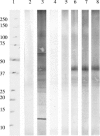Production and characterization of monoclonal antibodies against Enterocytozoon bieneusi purified from rhesus macaques
- PMID: 16041034
- PMCID: PMC1201209
- DOI: 10.1128/IAI.73.8.5166-5172.2005
Production and characterization of monoclonal antibodies against Enterocytozoon bieneusi purified from rhesus macaques
Abstract
Enterocytozoon bieneusi spores derived from rhesus macaque feces were purified by serial salt-Percoll-sucrose-iodixanol centrifugation, resulting in two bands with different specific densities of 95.6% and 99.5% purity and with a recovery efficiency of 10.8%. An ultrastructural examination revealed typical E. bieneusi spores. Twenty-six stable hybridomas were derived from BALB/c mice immunized with spores and were cloned twice by limiting dilution or growth on semisolid medium. Four monoclonal antibodies (MAbs), reacting exclusively with spores, were further characterized. These MAbs specifically reacted with spores present in stools of humans and macaques, as visualized by immunofluorescence, and with spore walls, as visualized by immunoelectron microscopy. A blocking enzyme-linked immunosorbent assay and Western blotting revealed that the epitope recognized by 8E2 was different from those recognized by 7G2, 7H2, and 12G8, which identified the same 40-kDa protein. These MAbs will be valuable tools for diagnostics, for epidemiological investigations, for host-pathogen interaction studies, and for comparative genomics and proteomics.
Figures






Similar articles
-
Monoclonal antibodies against Enterocytozoon bieneusi of human origin.Clin Diagn Lab Immunol. 2005 Sep;12(9):1109-13. doi: 10.1128/CDLI.12.9.1109-1113.2005. Clin Diagn Lab Immunol. 2005. PMID: 16148179 Free PMC article.
-
Production and characterization of monoclonal antibodies against Encephalitozoon intestinalis and Encephalitozoon sp. spores and their developmental stages.Parasit Vectors. 2017 Nov 9;10(1):560. doi: 10.1186/s13071-017-2503-z. Parasit Vectors. 2017. PMID: 29121996 Free PMC article.
-
Production of monoclonal antibodies directed against the microsporidium Enterocytozoon bieneusi.J Clin Microbiol. 1999 Dec;37(12):4107-12. doi: 10.1128/JCM.37.12.4107-4112.1999. J Clin Microbiol. 1999. PMID: 10565939 Free PMC article.
-
Purification of Enterocytozoon bieneusi from stools and production of specific antibodies.J Clin Microbiol. 2005 Jan;43(1):387-92. doi: 10.1128/JCM.43.1.387-392.2005. J Clin Microbiol. 2005. PMID: 15634999 Free PMC article.
-
Microsporidiosis: Enterocytozoon bieneusi in domesticated and wild animals.Res Vet Sci. 2011 Jun;90(3):363-71. doi: 10.1016/j.rvsc.2010.07.014. Epub 2010 Aug 10. Res Vet Sci. 2011. PMID: 20699192 Review.
Cited by
-
Therapeutic evaluation of polyamine analogue drug candidates against Enterocytozoon bieneusi in a SCID mouse model.Antimicrob Agents Chemother. 2009 Jun;53(6):2417-23. doi: 10.1128/AAC.01113-08. Epub 2009 Mar 16. Antimicrob Agents Chemother. 2009. PMID: 19289524 Free PMC article.
-
A new method of metabarcoding Microsporidia and their hosts reveals high levels of microsporidian infections in mosquitoes (Culicidae).Mol Ecol Resour. 2020 Nov;20(6):1486-1504. doi: 10.1111/1755-0998.13205. Epub 2020 Jul 1. Mol Ecol Resour. 2020. PMID: 32516485 Free PMC article.
-
Ecological and public health significance of Enterocytozoon bieneusi.One Health. 2020 Dec 24;12:100209. doi: 10.1016/j.onehlt.2020.100209. eCollection 2021 Jun. One Health. 2020. PMID: 33426263 Free PMC article. Review.
-
Patterns of genome evolution among the microsporidian parasites Encephalitozoon cuniculi, Antonospora locustae and Enterocytozoon bieneusi.PLoS One. 2007 Dec 5;2(12):e1277. doi: 10.1371/journal.pone.0001277. PLoS One. 2007. PMID: 18060071 Free PMC article.
-
Microsporidian infection is prevalent in healthy people in Cameroon.J Clin Microbiol. 2007 Sep;45(9):2841-6. doi: 10.1128/JCM.00328-07. Epub 2007 Jul 3. J Clin Microbiol. 2007. PMID: 17609328 Free PMC article.
References
-
- Albrecht, H., and I. Sobottka. 1997. Enterocytozoon bieneusi infection in patients who are not infected with human immunodeficiency virus. Clin. Infect. Dis. 25:344. - PubMed
-
- Canning, E. U., and W. S. Hollister. 1990. Enterocytozoon bieneusi (Microspora): prevalence and pathogenicity in AIDS patients. Trans. R. Soc. Trop. Med. Hyg. 84:181-186. - PubMed
-
- Carville, A., K. Mansfield, G. Widmer, A. Lackner, D. Kotler, P. Wiest, T. Gumbo, S. Sarbah, and S. Tzipori. 1997. Development and application of genetic probes for detection of Enterocytozoon bieneusi in formalin-fixed stools and in intestinal biopsy specimens from infected patients. Clin. Diagn. Lab. Immunol. 4:405-408. - PMC - PubMed
Publication types
MeSH terms
Substances
Grants and funding
LinkOut - more resources
Full Text Sources
Other Literature Sources

